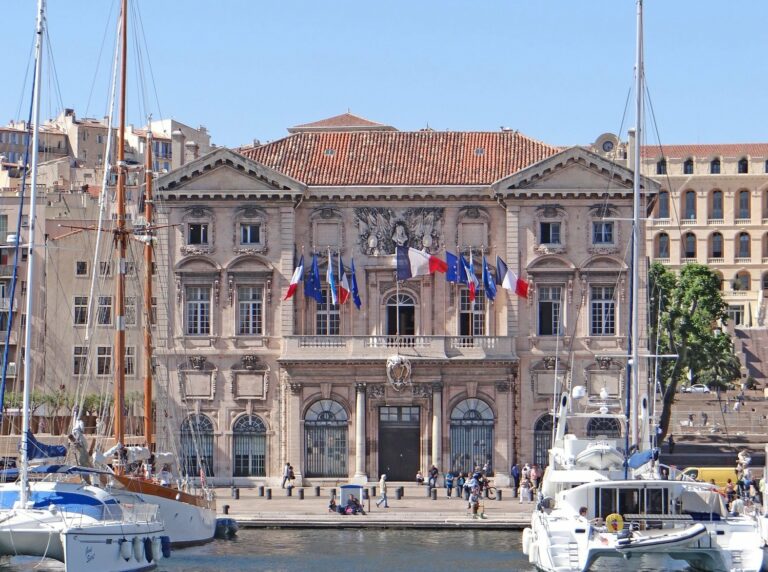Marseille might initially seem like just another large city, but it’s truly exceptional. Its deep-rooted history, vibrant culture, and breathtaking coastal landscapes set it apart.
Exploring the charming streets of Le Panier or diving into the fascinating collections at the MuCEM Museum are just glimpses of what Marseille has to offer. This city is packed with unique experiences that will captivate you. So, let’s explore the remarkable aspects of Marseille that make it an unforgettable place to visit.
Diving deeper into the specifics, Le Panier, with its narrow streets and colorful buildings, offers a glimpse into the heart of Marseille’s rich cultural tapestry. It’s not just about the aesthetic appeal; it’s a living history lesson.
On the other hand, the MuCEM Museum, standing at the waterfront, isn’t just another museum. It bridges European and Mediterranean civilizations through its exhibits, making it a pivotal cultural landmark.
Moreover, Marseille’s coastline, with spots like the Calanques National Park, provides stunning natural beauty that contrasts with the urban environment. It’s a perfect example of how the city harmonizes its historical charm with natural wonders.
In summary, Marseille is more than just its bustling city life. Its historical districts, like Le Panier, significant cultural institutions like the MuCEM, and natural attractions like the Calanques, all contribute to its uniqueness. By exploring these aspects, you’re not just visiting Marseille; you’re experiencing the essence of what makes it truly special.
Old Harbour
Upon my arrival at Marseille’s Old Harbour, famously known as Vieux Port, its enchanting allure and the historical ambiance immediately caught my attention. This port, with origins tracing back to 600 BC, isn’t just a place but a living history book. Walking along the quayside, the sight of ancient fortifications and cathedrals enriches the scenic beauty, making every step a journey through time.
A standout feature of the Old Harbour is the Notre-Dame de la Garde basilica. Situated atop a hill, this landmark watches over the port with a golden statue of the Virgin Mary, symbolizing the city’s guardianship over its seafarers. Not far from here, Le Panier, Marseille’s oldest quarter, beckons with its narrow alleys and vibrant facades, offering a glimpse into the city’s bohemian spirit.
For history enthusiasts, the Chateau d’If is a must-visit. This former prison island, immortalized by Alexandre Dumas in ‘The Count of Monte Cristo,’ is just a short ferry ride from the harbour. Equally compelling is the Abbeye Saint-Victor, with its crypt and Romanesque architecture, showcasing Marseille’s rich religious heritage.
Art and culture buffs will find the Museum of Civilizations a haven of exhibits that celebrate Marseille’s multicultural legacy. Meanwhile, nature lovers shouldn’t miss the Calanques National Park. A mere drive away, this park features dramatic limestone cliffs and azure waters, offering spectacular vistas and opportunities for hiking and exploration.
Le Panier
Le Panier, nestled in the heart of Marseille, stands as the city’s most historic and enchanting quarter. Walking its cobblestone paths, you’re instantly whisked away to a bygone era. This district brims with life, offering an authentic slice of local culture through its diverse eateries and coffee shops. For those eager to dive deep into the quarter’s storied past, an audio-guided tour is a brilliant choice. It leads you through landmarks such as the bustling Vieux Port, the stately City Hall, and the majestic Notre Dame Bonne Mère Basilica, enriching your visit with intriguing tales.
Art and culture pulse through Le Panier, with its walls painted in mesmerizing murals and frescoes that reflect Marseille’s dynamic art scene. The area’s small boutique shops are treasure troves of unique finds and perfect for picking up memorable souvenirs. Le Panier’s magic lies in its blend of historical immersion and a peek into the locals’ everyday lives.
Positioned ideally for further adventures, Le Panier is a stone’s throw away from the grand Cathedrale de la Major and the iconic Notre Dame de la Garde, both offering panoramic city views. History enthusiasts will find the Abbaye Saint-Victor, with its ancient crypt and captivating narratives, a must-visit. Meanwhile, nature aficionados will delight in the pristine beauty of Calanque d’En-Vau and Les Goudes, celebrated for their spectacular scenery and clear waters.
Le Panier encapsulates the spirit of Marseille’s old town with its narrow lanes, age-old edifices, and lively ambience. It’s a quintessential stop for anyone seeking a genuine and richly layered experience.
Fort Saint-Jean
Crossing the footbridge from the Museum of European and Mediterranean Civilisations (MuCEM), I was struck by the imposing presence of Fort Saint-Jean. This historic fortress stands as a powerful symbol of Marseille’s rich medieval heritage, making it a must-visit for anyone exploring the city.
Here’s why Fort Saint-Jean deserves a spot on your itinerary:
Firstly, its historical significance is undeniable. Constructed during the Middle Ages, the fort served as a key defensive structure, protecting Marseille from potential invaders. Wandering through its walls and passageways offers a unique journey back in time, allowing visitors to deeply connect with the city’s storied past.
Moreover, the views from Fort Saint-Jean are simply breathtaking. Its towering watchtower offers unparalleled panoramas of Marseille’s Old Port, the sparkling Mediterranean Sea, and the majestic Notre Dame de la Garde. This vantage point is ideal for capturing stunning photographs and soaking in the city’s scenic beauty.
In addition to its historical and visual allure, Fort Saint-Jean enriches your cultural understanding of Marseille. Pairing a visit here with a trip to MuCEM creates a comprehensive exploration of the city’s history and Mediterranean influences. This combination immerses you in Marseille’s evolution from a historical standpoint to its current cultural landscape.
MuCEM Museum
Cross the footbridge from Fort Saint-Jean and you’re greeted by the impressive MuCEM Museum, a beacon of modern design and enriching exhibitions. This cultural hub is a cornerstone for anyone keen on delving into the depths of European and Mediterranean cultures. Since its inauguration in 2013, coinciding with Marseille’s recognition as the European Capital of Culture, MuCEM has been a pivotal space for showcasing the intricate tapestry of the region’s history, boasting a collection that exceeds 350,000 items. The museum’s architecture, a contemporary marvel linked to the historic Fort Saint-Jean by a footbridge, injects vitality into the Old Town, marrying the old with the new seamlessly.
Venture into the MuCEM Museum to uncover the myriad narratives of European civilization and Mediterranean traditions. The museum’s exhibitions are thoughtfully curated, illuminating the myriad facets of the region’s history, from its ancient roots to its current dynamics. The rooftop terrace of the museum offers unparalleled views of Marseille and its bustling port, a sight not to be missed.
Beyond the walls of MuCEM, the adventure continues with a boat excursion from the neighboring Port of Marseille to the stunning Calanque d’En-Vau, or a visit to the revered Notre Dame de la Garde. The museum’s location near the Old Town also allows for easy exploration of the local art scene, with numerous galleries within walking distance. MuCEM stands as a testament to Marseille’s rich blend of historical, artistic, and contemporary influences, making it an essential stop for those wishing to experience the city’s cultural heartbeat.
Chateau D’if
Nestled on a rugged islet near Marseille, Chateau D’if commands attention due to its historical role as both a stronghold and a detention facility. Boarding the vessel destined for the isle, a blend of eagerness and apprehension washed over me. The voyage offered magnificent vistas of the Mediterranean Sea and the bustling port of Marseille, enhancing the anticipation of the visit.
Upon arrival, the formidable presence of Chateau D’if loomed. This prison island, etched into popular culture by Alexandre Dumas in ‘The Count of Monte Cristo,’ encapsulates a deep historical narrative. Touring the quarters of notable detainees, the stark disparities in living conditions became evident. Inmates of higher social standing were allocated marginally better accommodations, in contrast to the grim dungeons that housed the less fortunate.
The strategic location and historical depth of the island render it an essential destination for aficionados of history and classic literature alike. While walking along the fortress ramparts, I was enveloped by the imagined tales of despair and hope that pervaded these walls. The panoramic views encompassing Marseille’s Old Town, the illustrious Notre Dame de la Garde, and the Cathédrale de la Major, further enriched the experience of this excursion from Marseille.
Through this exploration, one gains a nuanced understanding of Chateau D’if’s significance in French history and literature. Its portrayal in Dumas’ narrative not only immortalizes the fortress but also invites reflection on themes of justice, resilience, and redemption. This visit isn’t merely a journey through a historical site but an immersive experience into the layers of stories and lives that have intersected with this iconic location.









